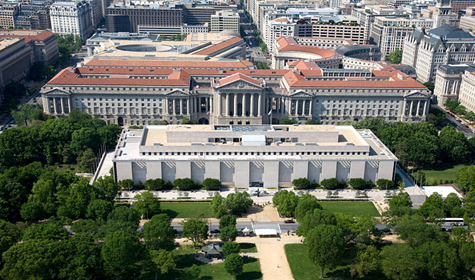

The National Museum of American History: Kenneth E. Behring Center collects, preserves and displays the heritage of the United States in the areas of social, political, cultural, scientific and military history. Among the items on display are the original Star-Spangled Banner and Archie Bunker's chair. The museum is part of the Smithsonian Institution and located on the National Mall at 14th Street and Constitution Avenue, N.W., Washington, D.C.
The museum underwent an $85 million renovation from September 5, 2006 to November 21, 2008, during which time it was closed. Skidmore, Owings and Merrill provided the architecture and interior design services for the renovation. Major changes made during the renovation include:
A new, five-story sky-lit atrium, which is surrounded by displays of artifacts that showcase the breadth of the museum's collection.
A new, grand staircase that links the museum's first and second floors.
A new welcome center, and the addition of six landmark objects to orient visitors.
New galleries, such as the Jerome and Dorothy Lemelson Hall of Invention.
An environmentally controlled chamber to protect the original Star-Spangled Banner.
Each wing of the museum's three exhibition floors is anchored by a landmark object to highlight the theme of that wing. These include the John Bull locomotive, the 1865 Vassar Telescope, the Greensboro, North Carolina lunch counter, a George Washington Statue, a Red Cross ambulance, and a car from a Dumbo Flying Elephant ride.
Artifact walls, 275 feet (84 m) of glass-fronted cases, line the first and second floor center core. The artifact walls are organized around themes including: arts; popular culture; business, work and economy; home and family; community; land and natural resources; peopling America; politics and reform; science; medicine; technology; and the United States' role in the world.
Outdoor sculptures
In 1967, the 24-foot tall abstract sculpture, Infinity, was dedicated at the National Mall entrance. Designed by José de Rivera and created by Roy Gussow, it was one of the first abstract sculptures displayed at a major public building in Washington D.C. The sculpture is a 16-foot-long, polished stainless steel ribbon on top of a granite tower.
Alexander Calder's sculpture, Gwenfritz, was installed in a fountain on the west side. The steel abstract stabile was dedicated to the museum on June 2, 1969.
The Lemelson Center produces educational programs, popular and academic publications, exhibitions, podcasts and symposia about invention. The mission of the Lemelson Center is to document, interpret and disseminate information about invention and innovation, encourage creativity in young people, and foster an appreciation for the central role of innovation in the history of the United States. The Center frequently provides a multi-year focus on some aspect of how invention has influenced American society, such as its 2002 "'Invention and the Environment" theme. Programs include an annual symposium, presentations and guest speakers, and often the publication of a book highlighting a particular topic.
The Center provides free curricular material to classrooms throughout the United States, organizes traveling museum exhibitions (such as Invention at Play), and provides research opportunities. It obtains archival collections related to invention for the museum's Archives Center. Such collections consist of the papers and materials that document the work of past and current American inventors.



















